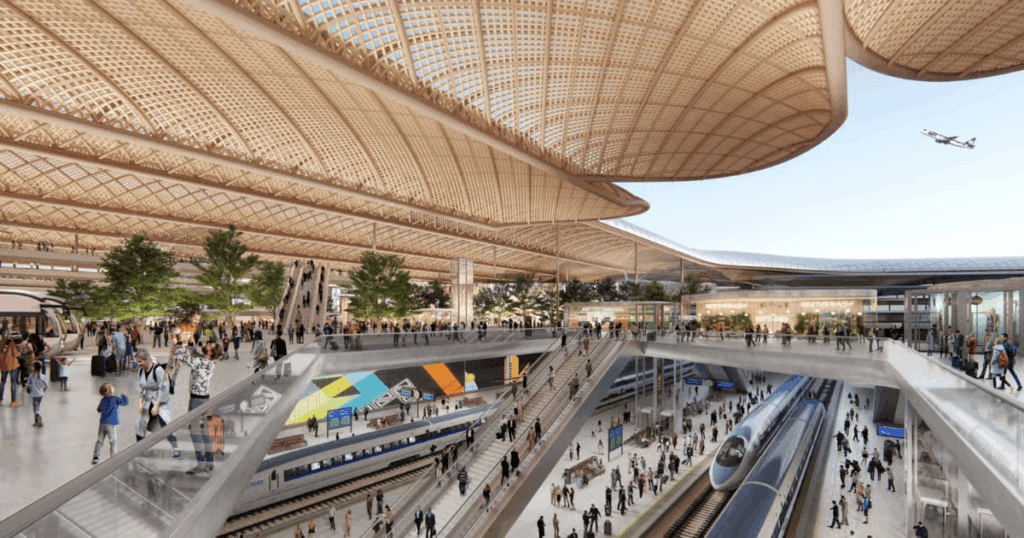Here’s our latest newsletter about the big projects and ideas shaping the cities of tomorrow.
You Should Know
- The FAA has decided to cap flight volumes at Newark Airport, one of the top 50 busiest airports in the world, through late 2025 to improve safety. Air traffic control, which has been chronically understaffed, lost contact with all aircraft for 90 seconds on April 29. Further network outages occurred on May 9 and May 11.
- Princeton, Texas has emerged as the fastest-growing city in the U.S., with its population doubling to over 37,000 as residents seek more affordable housing in the rapidly expanding Dallas-Fort Worth area.
- Modern China has achieved a historic, first-time annual decline in CO₂ emissions, driven by significant renewable electricity and electric vehicle adoption.
Worth Watching
- LEGO’s plastic problem and its plan to fix it.
- Inside the world’s largest 3D printed neighborhood.
- WeRide has launched China’s first 24/7 autonomous ride-hailing Robotaxi network.
Top Stories

Europe’s Next Great Travel Hub Is Rising
A massive €30 billion ($33 billion USD) mega project is set to transform European travel. Poland’s bold Central Communication Port (CPK) will be built 40 kilometers west of Warsaw, bringing together a new international airport with an expansive network of high-speed rail and roads. Designed to strengthen Poland’s position as a logistics hub, the project is expected to create up to 150,000 jobs and play a central role in reshaping mobility across Europe.
The CPK airport will be built on a 2,600-hectare greenfield site—twice the size of London Heathrow—making it one of the largest airports in the world by footprint. The terminal is expected to handle 40 million passengers annually at launch, with the capacity to expand to 100 million. Its vast scale is designed to support long-term growth, and the modular layout is intended to eventually accommodate up to four runways. At the core of CPK’s ground integration strategy is its high-speed rail (HSR) network. The plan includes building 2,000 km of new lines—supporting speeds up to 350 km/h—and modernizing 3,700 km of existing track. CPK will become the central node, enabling travel from the hub to cities like Kraków, Wrocław, and Gdańsk in under 2.5 hours. The HSR station, part of the airport complex, will also connect to the EU’s TEN-T corridor, enhancing cross-border mobility.
The project’s road infrastructure will upgrade existing expressways and construct new routes to ensure direct access to CPK from across the country. This multimodal integration is designed to support both civilian and strategic military needs, while reinforcing Poland’s central role in European transport.
Construction on the CPK is scheduled to begin in 2026, marking the start of ground preparation and development of the airport terminal, runways, and associated rail and road infrastructure. The airport is expected to open by 2032 with two 4,000-meter runways, a modular main terminal, and initial connections to Poland’s high-speed rail network.
AI Data Center of Jaw-Dropping Size to Rise in the Middle East
The U.S. and UAE are partnering to build a 5-gigawatt AI data center campus in the UAE—a major escalation in global infrastructure investment linked to artificial intelligence. The facility will be powered by up to 5 gigawatts of energy, a scale rarely seen in data center development.
At the heart of this effort is OpenAI, which is expected to anchor the massive site, spanning approximately 10 square miles—larger than Monaco and consuming power equivalent to five nuclear reactors. The project would far exceed the scale of OpenAI’s current facilities and marks a significant strategic expansion into the Middle East.
The campus will be built by G42, a state-backed Emirati firm, with American companies expected to help operate the data centers and deliver U.S.-managed cloud services across the region. While final commitments have yet to be announced, sources indicate that OpenAI is a central player, with Oracle also expected to contribute to the first phase of development.
This initiative is aligned with OpenAI’s broader Stargate program—unveiled in January with Oracle and SoftBank—to invest up to $500 billion in global AI infrastructure over four years. While the first Stargate facility in the U.S. is expected to have a 1.2-gigawatt capacity, the proposed UAE campus would be more than four times as large, fulfilling a vision OpenAI had originally outlined for the U.S.
Hydrogen vs. Electric: Bus Choices Divide City Planners
Cities worldwide are at a crossroads in modernizing their public transit fleets, weighing the benefits of hydrogen fuel cell buses against battery-electric buses. Both technologies offer zero-emission solutions, but their distinct characteristics present unique advantages and challenges for urban transportation.
Advocates for hydrogen buses highlight their quick refueling times—averaging around 15 minutes—and extended range capabilities, making them suitable for longer routes and continuous operation. Hydrogen buses operate by converting hydrogen gas into electricity through fuel cells, emitting only water vapor as a byproduct. This technology is particularly advantageous in cold climates, as performance remains consistent regardless of temperature fluctuations.
On the other hand, proponents of battery-electric buses emphasize their higher energy efficiency and lower operational costs. These buses run on electricity stored in onboard batteries, which power electric motors. Charging infrastructure is becoming increasingly widespread, and advancements in battery technology are continually improving range and reducing charging times.
However, each option has its drawbacks. Hydrogen buses face challenges such as high fuel costs and the need for specialized refueling infrastructure. Electric buses, while more energy-efficient, can experience reduced range in extreme temperatures and require longer charging periods, potentially impacting scheduling and route planning.
Market trends indicate a growing preference for battery-electric buses. In 2024, nearly half of all new city buses sold in the European Union were battery-electric, signaling a significant shift towards electrification in urban transit systems. Countries like the Netherlands, Finland, and Iceland have fully embraced electric public transport, with 100% of their new city buses in 2024 being battery-electric.
Despite this momentum, hydrogen buses are gaining traction in specific markets. The global hydrogen bus market is projected to grow from USD 1.87 billion in 2024 to USD 41.34 billion by 2032, with significant investments in Asia Pacific. Cities with longer routes and less developed electric infrastructure may find hydrogen buses more practical. As technology advances and infrastructure expands, both hydrogen and electric buses are poised to play pivotal roles in the future of sustainable urban transportation.

The New Blueprint: Panelized Construction Explained
Panelized construction is a specific type of off-site construction where key structural components—like walls, floors, and roof panels—are manufactured in a factory and then transported to a construction site for assembly. Unlike traditional construction, which builds most elements on-site from raw materials, panelized systems are engineered off-site, enabling faster and more controlled builds.
This method uses computer-aided design (CAD) and manufacturing tools to create precise building panels. These panels often come pre-fitted with insulation, window openings, and conduit channels. Once delivered, they are assembled on a prepared foundation, significantly cutting framing and enclosure time. Some systems use light-gauge steel over timber for added durability and environmental resilience.
Panelized construction offers several advantages: quicker build times, better quality control, less material waste, and fewer weather delays. It’s especially useful in regions with labor shortages or extreme climates. Still, it requires tight coordination between off-site production and on-site logistics—any delay in one can impact the entire timeline.
The global market for panelized construction is growing rapidly, driven by demand for affordable housing, urban density solutions, and sustainable building practices. Markets in North America, Europe, and parts of Asia are especially active in adopting this method.
Several companies are leading this shift. Hapi Homes uses a steel-framed panelized system offering fire resistance, dimensional stability, and resilience. Its hybrid model—factory-built panels and fast on-site assembly—allows it to deliver homes in as little as three months, making it especially appealing for affordable and emergency housing. Plant Prefab focuses on sustainability, using recycled and low-emission materials while offering highly customizable designs suited to urban infill and eco-conscious buyers. These builders brings distinct innovations to a growing segment redefining how homes are delivered.
Big Deals
- Blue Owl Capital closes its Digital Infrastructure Fund III with $7 billion in commitments.
- Lendlease and The Crown Estate forms $22 billion UK residential and commercial development JV.
- Dick’s Sporting Goods acquires Foot Locker for $2.4 billion.
- PowerBridge raises $1 billion to build gigawatt-scale data centers.
- Northleaf Capital Partners successfully closes its $2.6 billion infrastructure fund.
- Doral secures $1.3 billion for major Indiana solar projects.
Extra Reads
- Jumeirah launches transformative, luxury masterplan for 50,000 residents in Dubai.
- Amtrak in Seattle is getting a serious speed upgrade.
- China is carpeting mountains with solar panels, not just for energy production.
- Marsh explores best practices for managing risks in renewable energy.
- NYC launches microhubs for sustainable deliveries.
- Philadelphia installs speed slots to enhance safety.
- World-class architects appointed for York Central’s £2.5 billion regeneration.
- China adopts PPPs to finance major infrastructure in Africa.
- Motley Fools names the 10 most affordable cities in the U.S.
- California introduces new regulations for self-driving vehicle testing.
- DoorDash expands drone delivery partnership with Wing.